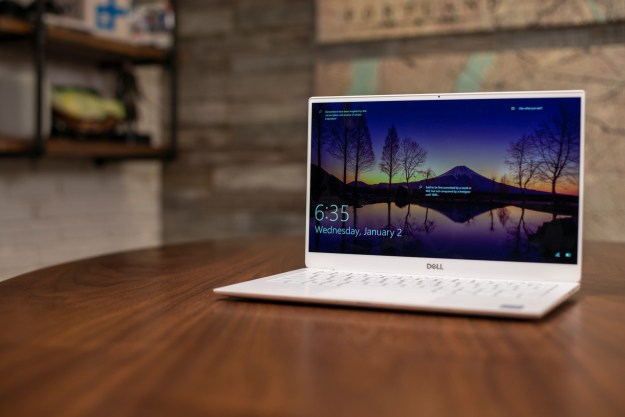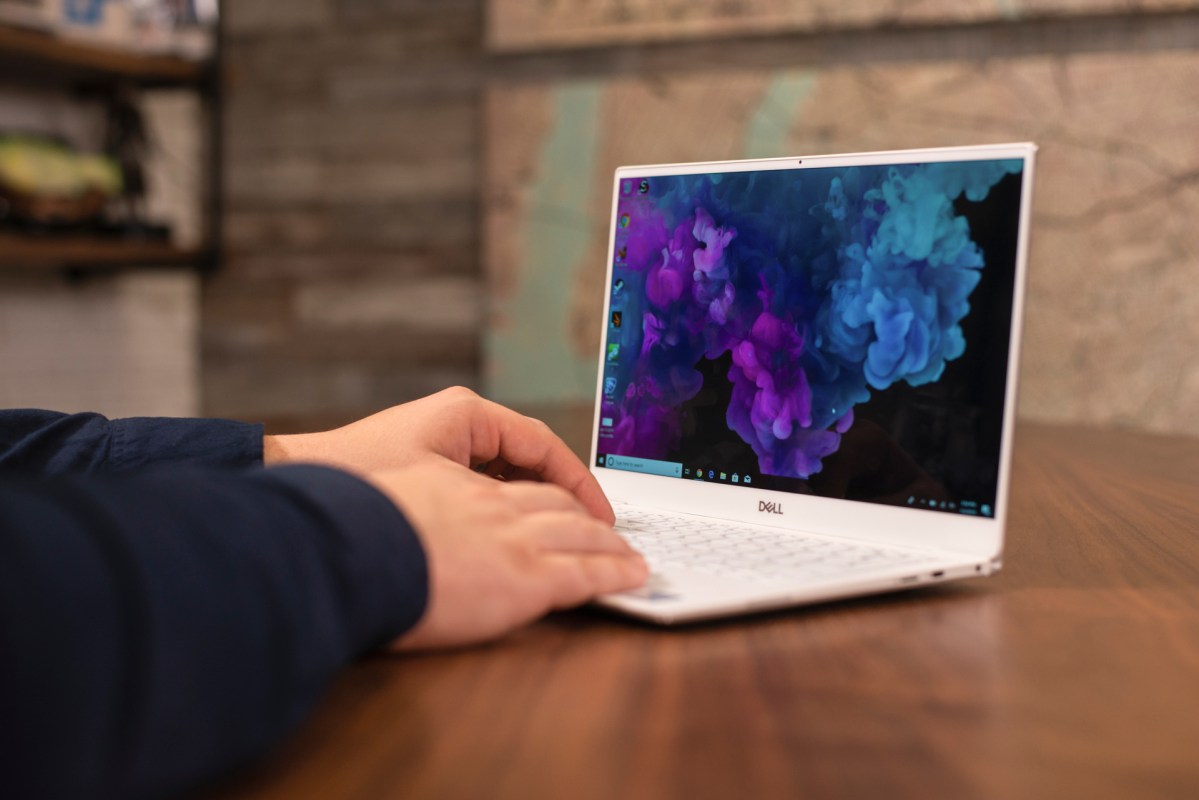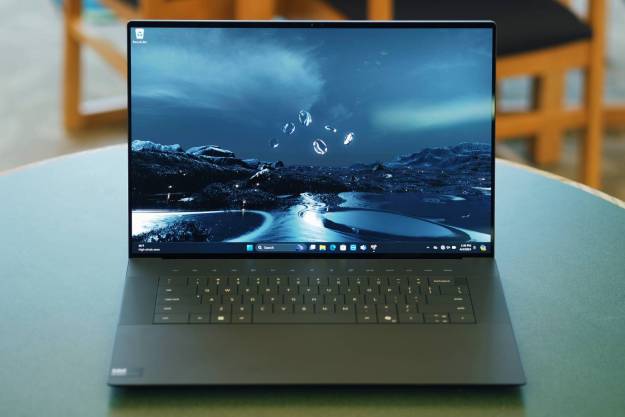
- Sleek design
- New colorways are great
- Webcam re-positioned
- Redesigned hinge opens easily
- Speedy, ultrabook performance
- Reduced battery life
Editor’s Note: Dell has updated the XPS 13 with optional availability of the newest 10th-generation Intel Core processors, including a six-core option. We had hands-on time with the new Dell XPS 13 7390.
Our wholehearted recommendation of the XPS 13 always came with one small but important caveat. The position of the webcam. Dell basically pioneered the problematic nose-cam located below the display. Now the company has fixed it.
The new XPS 13 has moved the webcam above the screen without also stretching the bezels. On top of that, the already-great laptop has a few tricks up its sleeve to sweeten the deal. Starting at $900, the base version of new XPS comes with a Core i5 Whiskey Lake processor, 4GB of RAM, and a 128GB SSD. Our 4K model, though, expands that up to a Core i7, 8GB of RAM, and a terabyte of solid-state storage.
It’s close to perfection.
A frosty sheen
The XPS 13 has always been one of our favorite designs. Thanks to super-trim bezels and 16:9 aspect ratio, it’s downright tiny compared to many similar laptops. Not only is that mobility great for squeezing some work onto a plane ride, it’s also extremely attractive. This time around, that design has been spruced up even more.
Color options is the first noticeable change. Last year’s model introduced the Rose Gold shell, paired with a bold, white interior — a combination we enjoyed. This year, Dell has added a colorway called “Frost” for the exterior chassis. It’s just silver, but it’s a lighter tone than what we normally see. It really pops when matched with the white interior. You still have the option for rose gold or the traditional black-on-silver combo, but this one is our favorite.

If you happen to go for one of the two white models, the woven glass-fiber material on the keyboard deck and palmrests has been lightened for a bolder and brighter white. We realize the use of plastic — and even the white color — isn’t for everyone. But if you’ve grown a little tired of the sea of silver, aluminum laptops, the XPS 13 will be a breath of fresh air. On top of that, Dell’s choice in textures and materials aren’t as prone to picking up fingerprints, which is appreciated. It’s a problem laptops like the Razer Blade Stealth still suffer.
Dell has also improved the hinge on the 2019 XPS 13. Previous versions of the laptop used a tight hinge that required two hands to open. The new hinge, called a “variable torque hinge,” requires less effort, meaning you can open it with just one finger.
Well, almost. There’s still no lip for your finger to grab, nor is it perfectly balanced like the MacBook Air or the Razer Blade Stealth. The lid tends to need some help from your other hand in the final 25 percent of its arc. Still, it’s a significant improvement over previous models.

The XPS 13 doesn’t claim to be the thinnest or lightest laptop in the world, but it’s far from clunky. At 0.46 inches thick (at its largest) and 2.7 pounds, it’s slightly thicker and heavier than the HP Spectre 13, but undercuts the Razer Blade Stealth and MacBook Air.
Port-wise, nothing has changed this time around. You get two Thunderbolt 3 ports, a standard USB-C port, a microSD card slot, and a 3.5mm headphone jack. A year or two ago we may have dinged the XPS 13 for not including a USB-A port. Today? It’s a good selection for a lightweight, portable laptop.
To InfinityEdge and beyond
Dell has worked on moving the webcam back to the top of the display since the launch of the iconic InfinityEdge bezels in 2015, yet the webcam stubbornly remained below the screen.
Fixing the problem wasn’t easy, but Dell has cracked it. By reducing the size of the sensor and cutting every sliver of wasted space, the bezel has only grown by less than a millimeter, and the webcam is back up top.
The XPS 13 also looks fantastic to the naked eye, easily overpowering the reflections of harsh office light.
The result? Video calls looks normal again. There is one trade-off, though. An infrared camera is no longer included, meaning the XPS 13 longer supports Windows Hello for login via facial recognition. To balance that, Dell added a fingerprint reader built into the power button.
Outside of the webcam, there are a couple of input changes worth mentioning. First, the keyboard has been redesigned with the key technology used in the newer XPS 15 2-in-1. Key travel isn’t as low as the XPS 15 2-in-1, but keys do have more spring. The caps are also less slippery than before thanks to a new texture. These tweaks don’t spoil the typing experience, and the Dell XPS 13 remains great to use.

Beneath the keys is the usual keyboard backlighting, which is bright but only offers two levels of brightness. That’s a bit behind laptops like the Apple MacBook Pro or Razer Blade Stealth.
The one thing that hasn’t changed is the touchpad, which is fantastic. The click is a bit louder than we’ve grown accustomed to, but tracking is precise and multi-touch gestures register as they should. Some competitors, most notably the Apple Macbook Pro, offer a larger surface, but the Dell XPS 13’s touchpad is enjoyable and feels more than large enough. Competitors like the Asus Zenbook UX333 offer slightly smaller, more awkward touchpads.
A display worthy of its bezels
The XPS 13 comes with three display options: non-touch 1080p, touch-enabled 1080p, and touch-enabled 4K. The new option here is touch-enabled 1080p, though we were sent the higher-resolution model for review. No matter which you choose, the panel included is one of the best you can buy.
The screen’s numbers are impressive, but the XPS 13 also looks fantastic to the naked eye. Overpowering the reflections of harsh office light is no problem. It can be cranked up to a retina-burning 472 nits, third only to the Huawei MateBook X Pro and MacBook Pro. Colors are vivid and look natural.
The contrast ratio of 980:1 doesn’t match top performers like the Asus ZenBook UX333UN or the HP Spectre Folio, but the gamma reading is perfect at 2.2. That means images look as bright as they should. The MacBook Pro and some high-end 15-inch laptops beat it out in color gamut, registering more of the Adobe RGB color space. But with 99 percent of sRGB, you probably won’t have reason to complain.

Our review unit’s 4K screen looked sharp, but as with other 13-inch laptops, we recommend sticking to 1080p. 4K is an expensive upgrade that reduces battery life. For that reason, the 1080p configuration is the option model most people should pick up. We haven’t tested it yet, but it uses the same panel as in the previous year, and it scored well when we last tested it.
The speakers, located on either side of the chassis, are fine. They’re loud, but at higher volumes they become a bit shrill. Laptops with forward-firing speakers like the MacBook Pro, MacBook Air, Razer Blade Stealth, or Pixel Slate, will do better, though none of them are exceptional.
Quad-core power with added storage
The 2018 Dell XPS 13 was among the quickest 13-inch laptops. That was thanks to the company’s redesigned thermal solution, which used two fans, two heat pipes, and even strips of Gore-tex fabric.
The same system is in place on the new model. But this time, it has the added benefit of the latest ‘Whiskey Lake’ Intel Core processors. You have the option of either the Core i5-8555U or the Core i7-8565U. Both are quad-core and plenty quick. Our unit also came with 8GB of RAM and 512GB of storage, making for a capable, well-rounded laptop.

In Geekbench, we saw modest performance gains over the prior year., The 2019 model beats last year’s by about eight percent in both single and multi-core performance. That’s not the kind of difference you’ll notice in day-to-day use. In some tests, such as our benchmark that encodes a short 4K video in Handbrake, the 2019 XPS 13 saw no gain at all.
Still, the XPS 13 remains a top option. Other laptops with Intel’s newest ‘Whiskey Lake’ processors have shown their own modest improvements and generally don’t beat the XPS 13.
Storage options have slightly changed. All drives are now NVMe, with read and write speeds well over a thousand megabytes per second, and capacities range from 128GB all the way up to 2TB. Although 128GB isn’t a lot, we like that Dell offers a smaller version for those looking to buy at a budget price. Most premium laptops offer a minimum of 256GB, and have a higher base price as a result.
Not for gaming
The XPS 13 isn’t meant for serious gaming. Again, it’s hard to blame Dell for that. Intel’s integrated UHD 620 Graphics doesn’t offer much in terms of gaming prowess.
Laptops like the MateBook X Pro, Asus ZenBook 13 UX331UN, and Razer Blade Stealth all feature an Nvidia MX150, and therefore provide a bit more gaming and video rendering power. If you need that kind of capability, the XPS 13 isn’t for you. We hope to see that change with Intel’s upcoming move to Gen11 integrated graphics, but that won’t arrive until late 2019.
A dip back in battery life
The XPS 13 has always been a pack-leader in the area of battery life. That’s the 1080p version, though. Battery life takes a hit with a 4K display, regardless of what laptop it is. On the 2019 XPS 13, it’s a bigger drop than normal.
The 2019 XPS 13 dips in benchmarks that test usage in lighter tasks over long periods of time. We saw a 25 to 30 percent drop in light web browsing and local video loop playback over last year’s model. That’s strange considering the same display and battery are at use here. Dell claims the Whiskey Lake CPU draws slightly more power, but we haven’t seen that effect replicated in other systems yet. It still does better than the Razer Blade Stealth, though, despite having a higher-resolution screen.

The good news is that in a heavier load, the 2019 XPS 13 performs better than last year’s model. We’re getting an increase of 33 percent over last year’s, lasting over five hours in Basemark, an online benchmark that tasks the system more heavily. That means if your workload includes an intensive application, multiple monitors, or just dozens and dozens of browser tabs, the XPS 13 won’t die out right away. We were still able to get through most of a workday on our moderate workload without searching for an outlet.
Even still, the 1080p version is the one to pick for portability Last year’s 1080p model saw upwards of ten and a half hours in web browsing battery life, and over thirteen and a half in video lop. According to Dell, the 2019 version will see a bit of a drop from those numbers, but you can at least expect a couple more hours than the 4K model.
We’re not happy to see the decrease in battery life, especially when options like Chromebooks, Y-series thin-and-light laptops, and Qualcomm-powered 2-in-1s are making some leaps forward. The Dell XPS 13’s battery life is still solid, but it’s no longer ahead of the pack.
Our Take
The new Dell XPS 13 answers a lot of the problems we had with the original. It shows the company is willing to take feedback, then actually do something about it. That’s commendable. On top of that, the new XPS 13 doesn’t compromise any of the things it did well in past iterations. It might not be perfect, but it’s as close as we’ve seen so far.
Are there any alternatives?
The 13-inch category is stacked with competitors — we review a lot of laptops at Digital Trends — but most make more compromises than the XPS 13.
The Spectre 13 is HP’s alternative, though it doesn’t have the performance or design pedigree to challenge the XPS 13. Microsoft has its own Surface Laptop 2, which has a larger 3:2 screen but is hampered by an outdated port selection. The Razer Blade Stealth is fantastic but comes in a few hundred dollars more expensive. The Lenovo Yoga C630’s screen can’t touch the XPS 13.
Apple fans will most likely choose the MacBook Pro or MacBook Air, but the XPS 13’s longer battery life, better performance, thinner bezels, and more tactile keyboard make it a better choice than either fruity laptop.
How long will it last?
The XPS 13 is a well-built, forward-looking laptop. That’s true of the various top-of-the-line components included here and the port selection. It should last more than a few years under normal wear and tear.
The XPS 13 comes with a standard one-year warranty. That’s typical for a new laptop.
Should you buy it?
Yes. It’s the best 13-inch laptop you can buy, and no longer held back by an awkward webcam.
Editors' Recommendations
- Wholesale laptop deals: How to buy cheap computers in bulk
- The 10 best monitors for 2024: tested and reviewed
- 9 best 2-in-1 laptops in 2024: tested and reviewed
- Best 14-inch laptops for 2024: tested and reviewed
- 10 best gaming monitors of 2024: tested and reviewed



